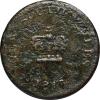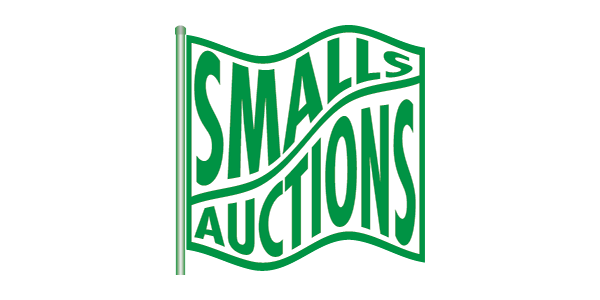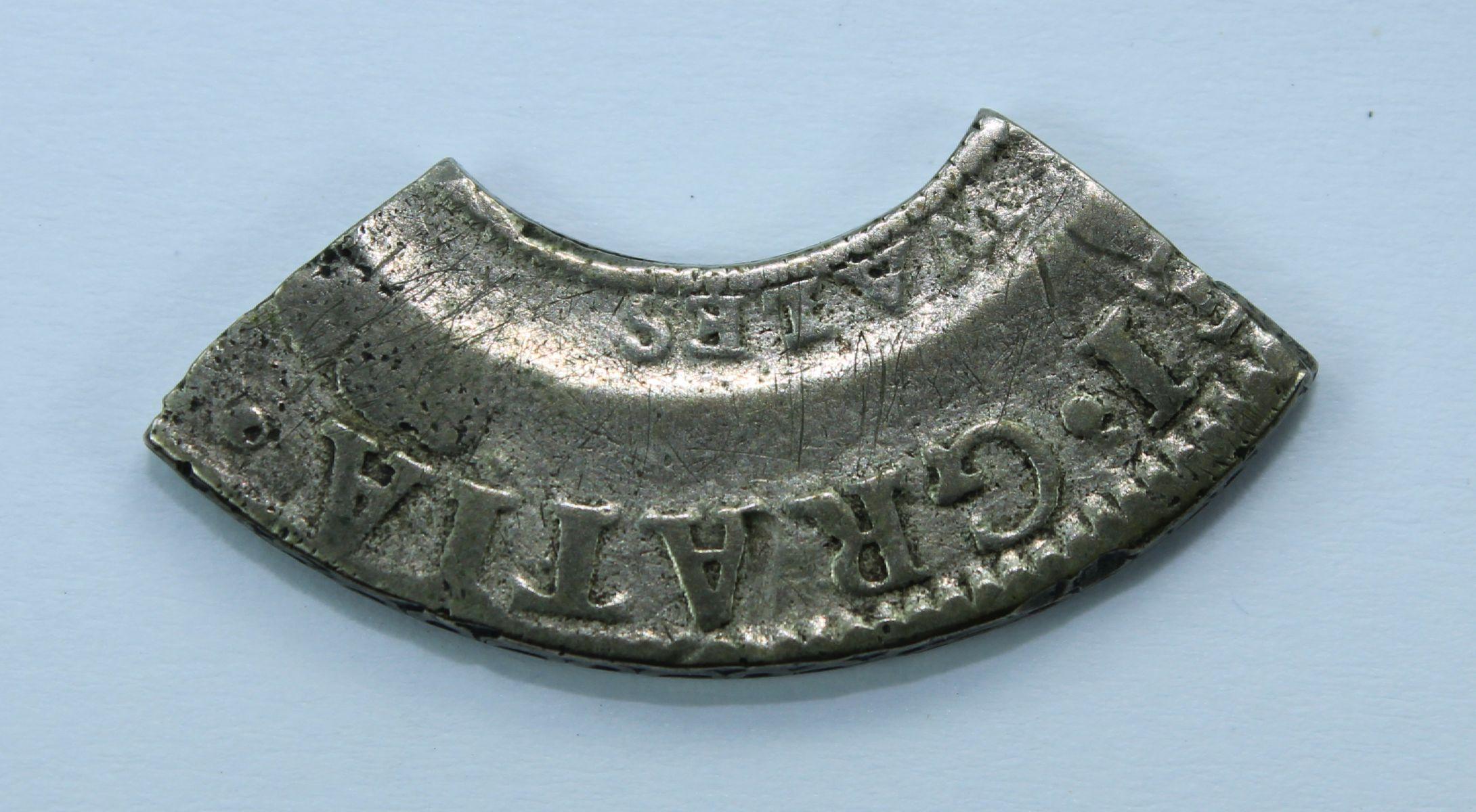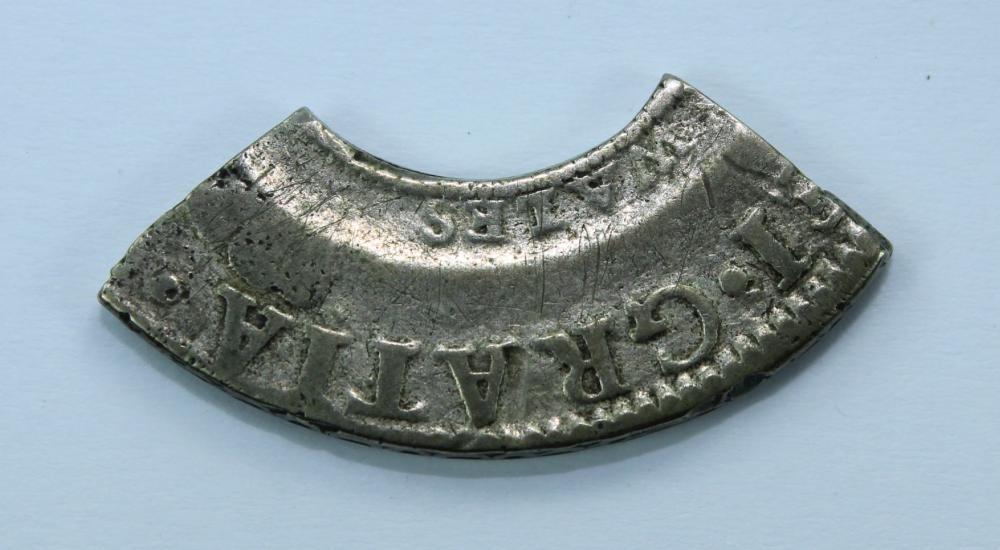Lot 111


Unique & Museum Exhibit Standard. Accompanied by a rare First Edition copy of Coleman P. Hyman's 'Coins, Coinages and Currency of Australia' (1893) & a bound copy of the 'Comic History of New South Wales' (from 1777-1877). Struck on a contemporary forgery of a Holey Dollar this coin is a cut Quarter Section which would equate to a value of 1 & 1/4 Shillings of 15 Pence. It is a unique survivor probably having been cast aside in a trader’s drawer when it was realised that they had been passed a coin made of debased silver. The author Coleman P. Hyman mentions this specific coin in the collection of the politician Henry C. Dangar in his important work titled ‘an Account of the Coins, Coinages and Currency of Australasia” which was published in conjunction with a display of Australian currency at the 1893 World’s Columbian Exposition in Chicago. Coleman references another publication the ‘Comic History of New South Wales’ as being a primary source of information regarding the practice of sectioning Holey Dollars to create smaller denominations. Hyman also mentions that some believed that Dumps were also quartered to create threepenny coins. Certainly, the coins of the Caribbean on which Governor Macquarie based the Holey Dollars and Dumps were sectioned into ‘bits’ of smaller denominations although there is no official record of this practice being sanctioned in New South Wales.
-
Provenance:
- Ex Henry C Dangar Collection sold Lawson;s Auctions 1953 Dimensions:
- Length 28.92mm: weight 5.05gms Exhibited:
- 355 Literature:
- Collectibles Medium:
- Coins, Monies & Stamps Circa:
- Coins, Australia & New Zealand Notes:
- The history of the NSW 1813 Dumps has been thoroughly recorded through the years, but it wasn't until 1974 that the late author Dr W.D 'Bill' Mira adopted a more studied approach when he introduced an alpha-numeric system to re-classify the 'official' NSW 1813 Silver Dumps into distinctive types and was able on a cursory examination to fit them neatly into four combinations. Fourteen years later in his publication 'The Holey Dollars of New South Wales' he had determined that about 70% of surviving dumps were of the A1 type, 25% were D2 with the E3 and C4 types making up the remaining 3% and 2% respectively. Even though the existence of the four basic varieties of the dumps was already well documented, Mira's more scientific classifications quickly replaced the ill-fitting adjectival descriptions that had earlier been relied upon. Using Mira's system, you can now confidently identify the Dump with the unusual 'sinister' exhibited by Coleman P. Hyman at the World's Columbian Exposition in Chicago in 1893 in his display of the 'Coins, Coinages and Currency of Australasia' as the rare Type C. So, which of the four commonly recognised Dump types was the first struck? To determine the timeline of the striking of the various silver dumps you should also look at the history of the 'unofficial' copper dumps that circulated at the same time in Colonial Sydney. Collectors of Australian Colonial coins would be aware of these contemporary forgeries that turn up in sales from time to time. In a penal colony inhabited by so many resourceful criminals, it was hardly surprising that someone would look to make copies of a coin with such a simple design. It is estimated that 20-30 of the copper forgeries have survived most of which were unearthed in 1927 when a section of Pitt Street, Sydney was excavated for the installation of the City Circle Train Line. They were all heavily circulated and having been buried for a hundred years their surfaces were now grainy and pitted. All the discovered dumps were struck on the same set of crude dies suggesting that just one forger was responsible for the criminal enterprise, however, it is noted that some examples were more complete than others having either plain edges or simulated edge milling much like the genuine silver dumps. The purity of the copper suggests that the planchets used to strike the forged dumps were derived from British pennies and halfpennies that were common in Colonial Sydney. Metal analysis also reveals minute traces of a silvery lead wash which would have coated the forgeries to make them more convincing when they were passed off as real dumps in quick transactions, and it is this added characteristic that may point to the maker. But not all copper dumps were crude forgeries meant to fool. Mira, in his collection, held both D2 and E3 dumps that were struck in copper, and which exactly mirrored the silver strikings. So, the question that needs answering is why 'official' D2 and E3 Dumps were struck in copper in the first place and by whom. Mira speculated that the copper trials he owned were struck by the convict die-maker William Henshall with the imprimatur of Governor Macquarie, to 'test the machine(ry)' before the dies were used for the silver strikings and this theory was all but confirmed in 2007 with the discovery of a Holey Dollar struck on 'Factory' dies on a Great Britain 1799 Halfpenny which sold for $233,000. Surprisingly, this coin turned up on Vancouver Island in Canada accompanied by a copper Dump of an unknown type, which unfortunately was sold off before the significance of the find was realized, because there is strong circumstantial evidence that both trial strikes were souvenired by William Henshall himself. They are also the only Holey Dollar and Dump that could possibly be matched up. I have tested the 'Mira' copper E3 Dump with a metal analyser, and like the contemporary forged copper dumps, it shows the remnants of a silvery lead wash probably to show Macquarie how the silver strikings would look. As it turned out Henshall's copper trials looked convincing enough that they too eventually made it into circulation as is evidenced by their worn state. Generally, the contemporary copper forgeries show such poor detail that it is difficult to distinguish all but the basic characteristics but recently a better-detailed example turned up which I was able to compare with a similarly graded D2 Dump, and to my surprise I noticed a startling familiarity existed with the size and shape of crowns which except which for a change to the orb at the top of the design are millimeter perfect. They are not identical twins but the shapes of some of the letters in the legends are also a close match and they look to be out of the same family. So, did Henshall trouser some of the punches he used on the silver dumps before he left the Government employ? We will never know for sure but if you were seeking to convict someone on circumstantial evidence, I think you could run a fairly good case. Because of his hands-on knowledge, Henshall was always going to be a prime suspect as the source of the forged copper dumps circulating in the Colony, and perhaps as a deterrent, he received an unusually severe flogging on the direct orders of his past employer Governor Macquarie for the relatively minor infraction of trespassing on Sydney's Domain. The suspicions were never proven but, when his wife died in 1817, Henshall decided it was time to take leave of Sydney and sailed on the 'Chapman' bound for England. There are no further records of his life or death, but tellingly there are a very sizeable number of Henshalls (an uncommon name in a small community) buried on Vancouver Island where the copper Holey Dollar and Dump trials were later discovered, strongly suggesting that this may be the final resting place of Australia's first 'Mint Master.' But, you cannot have a copy without first having an original and my research suggests that the E3 Type were likely the first dumps struck, making the 'Mira's' E3 copper trial the earliest known surviving Dump. Mira catalogued the most commonly found coins as his A Type but they were certainly not the first variety struck as it makes no sense that a more finished design would predate the rough and ready 'experimental' E3 and C4 types. But which of the E3 or the C4 types came first and were they then followed by the A1 or the D2 and, what has happened to the missing 'B' in Mira's alphabet? In his research, Mira could well have turned up historical descriptions of coins that did not seem to fit comfortably within his four types, and at one time he may have considered a fifth 'B' type obverse for the dumps. However, our inquiries with his co-collaborator on his 1988 work could shed no light on his thinking. Certainly, I have thought for several years that a new reverse type should apply to a small proportion of A1 Dumps that show significant serifying on the reverse letters when compared to the block type found on most A1 dumps. Initially, I thought a new reverse Type '5' should apply, but in light of a recent new discovery, and because these coins fit within all the other existing parameters that define an A1 Dump, I would now suggest that a new Type '1a' Reverse is more appropriate. This serifying is harder to pick up on worn dumps, and so it is difficult to arrive at a split, but it would appear that the plainer reverse lettering was probably the result of the original A1(a) reverse die being re-cut and simplified quite early on in production resulting in the dominant A1(c) variety. This progression appears to be the opposite on the on 'experimental' C4 Dumps with a move from block to serifed lettering on the reverse. Except for spacing, the reverse used on the C4 dumps that show serifing is not too different to the reverse used on the A1(a) Type and this can be explained by evidence of re-cutting as Henshall experimented with the placement of the reverse letters. The reverses on other C4 dumps have block-type letters that more closely resemble the A1(c) as well as the E3 and D2 types. For consistency and reasons, I will explain later I have labelled the serifed reverse 4(b) and the reverse showing block type as 4(a). The recent new Dump discovery we have mentioned is an A Type of Dump struck in brass which has proven to be quite revelatory. On examination, it appears to have been an off-metal trial strike in brass to test the progressive changes that Henshall was undertaking on the reverse font used on the 'Fifteen Pence' moving from a more complicated serifed lettering to a simpler block type before he progressed to the striking of the silver dumps. It is itself a work in progress with the serifying identified on the tops of the letters of 'FIFTEEN' on the 'A1(a)' Type Dump largely squared off but still remaining on the tops of the letters of 'PENCE.' Like all high-grade coins identified as the A1(c) type, the obverse of this trial has a small pimple above the '3' in the date, a marker that is not evident on dumps that fit the A1(a) type. This places this unique brass trial between the striking of the A1(a) Dumps and its A1(c) derivative as it captures the evolution of the Dump as Henshall works through refinements to the design. This combination of dies I have labelled the A1(b) Dump which besides the brass pattern is also represented by a small number of silver dumps. However, the 'missing link' in the evolution of the Dump appears to be another off-metal strike that differs substantially from the A1, C4, D2, and E3 silver dumps that are commonly accepted as being struck at 'The Factory' by William Henshall. This copper Dump turned up a few years ago and although it is unique in its composition it has certain characteristics that link it to the A1, C4, and D2 types. The most observable difference on this coin is the shape of the crown on the obverse which is taller but also shorter in the base than the styles adopted on the other types but is closest in look to that found on the more finished A and D obverses. Certainly, the cross with the tilted support atop the crown mirrors the shape of the A and D types as do the fleur-de-lis within the design. The beads in the crown alternate between large and small like the A type but without its left-to-right upward slope and are closer in orientation to the D obverse where the uniform beads are centered. Like on the D type, the cross on the crown points slightly to the left of the 'T' in 'SOUTH' but the placement of 'N' of 'NEW' the 'S' of 'WALES' is closer in orientation to the A type. All of the four acknowledged dump types have stylised Arabic 1's in the dates, but unfortunately on this new type, inopportune surface corrosion makes it difficult to determine whether the tips of the '1's' are missing or just lightly struck, but certainly as with the A obverse, the second '1' appears slightly skinnier than the first and the '8' is crossed over which is also observed on high-grade A type dumps. The '3' however is struck in a totally new font not found on any other type. This digit does not have the downward bend on the top bar of the '3' found on the A and D types, and although straight like on the C and E dumps, it has a distinctively shortened top along with a fully formed 'V' between the two segments of the '3' which alters the shape of the inner void at the bottom. Overall, this copper trial exhibits a new obverse that is not found on any known circulating silver dump, and it may well be Mira's unresolved 'B' Type representing a coin description he may have come across in his years of research that did not quite fit any known coin. Its obverse is certainly more highly detailed than either the E3 or the C4 dumps, and because of its hybrid nature, it may have been a reference type used by Henshall as he transitioned between the D2 and A1 designs. The reverse of this copper coin is equally revealing, as it too has a version of the serifed lettering found on the 4(b) and 1(a) reverses that we have identified but it is an inexact match to both types. The serifying is much more florid on the 'F' and particularly the 'T' of 'FIFTEEN' suggesting it could predate the 4(b) reverse where this characteristic has been considerably toned down, but like this C reverse there is evidence of re-cutting which is especially evident on the 'N' of 'PENCE' which has been slightly repositioned. Again because of the stark differences between the acknowledged reverse types 1, 2, 3 & 4 and the proposed derivatives I have sequenced it as a new Type 5 to recognise its unique stature. Like all the 'official' and 'unofficial' copper dumps that I have encountered, it too shows remnants of a silvery lead wash when tested on a metal analyser which was no doubt applied by Henshall to demonstrate to the authorities the potential look of a proposed silver dump. While the B5 may have been used solely by Henshall as a reference type it could also have been a full obverse and reverse revamp that he had envisioned for the Dump, but after two hundred years no silver dumps of this type have been identified in circulation and so it can be safely assumed that this unique copper trial never made it to the follow-up experimental stage that produced the limited numbers of silver E3 and C4 dumps, which themselves were probably not meant to circulate. I have requisitioned Mira's missing 'B' to label this 'missing link' as the B5 Type. So how does this help us solve the conundrum of the dumps? In summary, the brass and copper off-metal strikes and the C4(b) Dump variety appear inextricably interwoven with the development of the A1 Dump but the crude nature of the C Type itself suggests that Henshall pulled out of the cupboard the original discarded C4 (a) design with reverse block type to experiment with when developing the A1(a) reverse. It also seems improbable that Hensall would have taken a backward step to start experimenting with a cruder E3 type after the highly detailed A1 and D2 types had been produced and as the crown on the C Type obverse is closer in shape to both the A1 and D2 types it stands to reason that the E3 was the first Dump produced most likely followed by the C4(a), the earliest incarnation of the C4 Dump. That leaves us to determine the order of the A1 and D2 dumps the latter of which also exists as a copper trial. And the answer to where these two types fit in the pantheon of dumps appears to lie with the B5 copper trial. Although the obverse of the B5 Dump has its own unique features it also has a hybrid of characteristics shared by the A1 and D2 types in terms of the crown and the orientation of its legend. On balance the obverse of this unique trial looks to be transitioning towards the A1 Type and not away from it which would suggest that the D2 Dump came first. This seems confirmed on the reverse of the B5 which is clearly a stage in Henshall's experiments with serifed lettering that is observed on the C4(b) variety, the early A1(a) dumps and the A1(b) brass trial and silver dumps. As the E3, C4(a), D2 and also the later A1(c) dumps all have block type lettering on the reverse this would suggest that Henshall tried prettying up the reverse lettering of the new A Type with serifying through a series of copper, silver and brass trials which led to the striking a few silver dumps with this hybrid reverse before abandoning the idea altogether and reverting to the block type. So, in answer to the original question posed as to which of the 'official' standard dumps came first, the most probable sequence was the E3 type followed by the unaltered C4 Dump followed by the D2 and with the A1 bringing up the rear. But if you want to include all the known varieties then it would run: E3 copper; E3 silver; C4(a) silver; D2 copper; D2 silver; B5 copper; C4(b) silver; A1(a) silver; A1(b) brass: A1(b) silver and A1(c) silver. Personally, I would tag on to the end of the run of 'official' dumps the 'contemporary' copper forgeries that circulated in the Colony alongside the silver dumps, as they were most likely produced by the same hand. In a currency-starved Sydney they were a part of everyday commerce and deserve a place alongside the 'illegal' paper Promissory notes to which the authorities turned a blind eye. Of course, the caveat to my theory on the dumps is what lurks unresearched in institutional collections including the Mitchell Library which holds over one hundred specimens. I have only based my analysis on the coins I have encountered over the last 40 years of coin trading and the discovery of a new trial could well turn my thinking on its head. (Mark Duff - Smalls Auctions)
Accepted Forms of Payment:
American Express, MasterCard, Money Order / Cashiers Check, Other, Paypal, Visa, Wire Transfer
Shipping
AUSTRALIA: Purchases within Australia will be charged a MINIMUM SHIPPING FEE of $5.50 and will be sent by Registered Post. Additional insurance is optional at the buyer's expense.
INTERNATIONAL: Overseas purchases will be charged a MINIMUM SHIPPING FEE of $20.00 and will be sent by Registered Post International. Additional insurance is optional at the buyer's expense.
Both Australian and International packages are traceable in transit and require a signature on delivery.
Smalls Auctions
You agree to pay a buyer's premium of up to 20% and any applicable taxes and shipping.
View full terms and conditions
| From: | To: | Increments: |
|---|---|---|
| A$0 | A$249 | A$5 |
| A$250 | A$999 | A$10 |
| A$1,000 | A$4,999 | A$25 |
| A$5,000 | A$9,999 | A$50 |
| A$10,000 + | A$100 |





